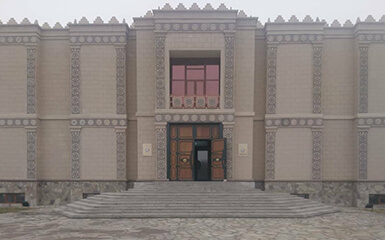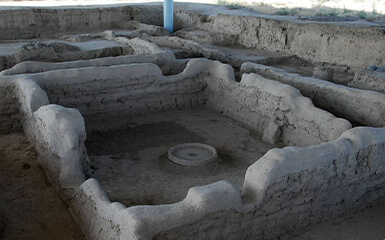Kok Gumbaz
Ajina Teppa
Ancient Panjakent
Anzob Tunnel
Beshkent Qala
Childukhtaron
Khazrati Shokh
Mug Teppa
Gharm Chashma
Hisor Historical
Haji Yaqub mosque
Hazrati-Bobo complex
Lake Iskanderkul
Kalai-Khumb
Karatag
Karon
Khishtin caravanserai
Khorog
Khulbuk
Lake Karakul
Abdullatif Sultan
Madrasai Kuhna
Abu Abdullah Rudaki
Khoja Mashhad
Khudoyor Valami
Makhmudi Azam
Mir Sayyid Ali Hamadani
Muhammed Bashoro
Sheikh Muslihiddin
Nurek Mountain Lake
Pamir
Sarazm
Sari-Khosor
Seven Lakes
Shirkent
Chiluchorchashma
Takht-i Sangin
Proto-urban site of Sarazm

Sarazm is located in the western tip of Tajikistan, about 5 km from the Uzbek border. Samarkand is only 50 km away. It is possible to visit with a day trip.
Sarazm is the archaeological site of a proto-urban settlement dating from the fourth millennium BC to the end of the third millennium BC. The ruins show early development of human settlements, with initial urbanization, early cattle breeding, then agriculture, and then the presence of commercial and cultural exchanges.
Sarazm was only rediscovered in 1976, and excavation began soon after and is still ongoing. The four layers of stratification are interconnected. The most important archaeological find at the site is the burial place of a woman with beautiful jewellery. She is called the "Lady of Sarazm" and her remains are displayed at the National Museum of Antiquities in Dushanbe.
The entire area is fenced and can be visited free of charge. It consists of five excavation sites, all of which are covered with a steel roof for protection. In fact, there is not much to see apart from the 1-meter high walls, but it should not be forgotten that the city is 5500 years old. Small museum located nearby, probably more to see.
The site seems to indicate the presence of a steppe in the Zarafshan Valley at the time of its establishment. Around -3000, it was the largest metallurgical export centre in Central Asia. The place was abandoned when the Andronovo settlers arrived around -2000. The discovery of this site made it possible to refute the established idea that the Achaemenid period was the first agricultural settlement in this region.
It is then assumed that the city was reconstituted around a turquoise mining activity. By -1500, the city had become an important regional centre for agriculture and a centre of copper production.
Traces of wheat and barley (bare or in shell) were discovered on the site. On the other hand, no trace of millet or legumes was found there. Bare barley found at Sarazm exhibits a morphology comparable to traces found in ancient sites in Pakistan such as Mehrgarh and Nausharo and in China, where the earliest use of barley has been recorded.
A local farmer named Ashurali Tailonov who found a copper dagger near a construction site discovered the proto-urban site in 1976. Abdullo Isakov and French archaeologists then excavated the site in 1977.

